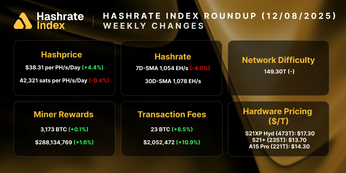
Advanced Hashrate Hedging Strategies for Professional Bitcoin Mining Companies
Hedging isn't a one-time fix but rather a dynamic, ongoing strategy within your broader risk management toolkit.
Before the advent of hashrate derivatives, Bitcoin miners had limited options to hedge against hashrate exposure. Existing hashrate marketplaces lacked optionality, standardization, and sufficient liquidity; cloud mining platforms imposed rigid pricing, payout, and margin requirements; bitcoin futures and forwards failed to protect revenue against parameters such as changes in network difficulty or transaction fees. As a result, many of the advanced hedging strategies available to traditional commodity producers were unavailable to Bitcoin mining companies.
Fortunately with Luxor’s Hashrate Forward market, Bitcoin miners can now implement a range of advanced hedging strategies. Here are four examples.
Strategy #1: Hedging for Later
In legacy hashrate markets, hashrate delivery begins immediately after contract execution for set durations (e.g., 30-180 days). For example, a Bitcoin miner can sell 50 Petahash (PH) through a cloud mining platform on August 20 for the next 30 days in return for 1.1 BTC, delivering hashrate from August 21 to September 19. Although this contract provides downside protection (i.e., if hashprice falls) to a miner throughout the duration, its utility is severely limited for a professional Bitcoin mining company due to an inability to lock in a future hashprice unless delivery begins immediately.
Perhaps the miner wishes to hedge the calendar month of September on August 20, with delivery beginning September 1 and ending September 30. A seasonal trade like this would be the norm in traditional commodity or agriculture markets. However, this trade is impossible in legacy hashrate markets. The miner would have to wait until September to execute the contract, bearing hashprice risk in the meantime, which ultimately defeats the purpose of the hedge.
On Luxor’s Hashrate Forward market, hashrate delivery can begin up to six months after contract execution for customizable durations [1] with standard monthly contracts listed in our Order Book. For example, if a miner wants to implement a hedge at the the time of an ASIC purchase: they can sell hashrate forward, with delivery beginning in 8-12 weeks, to allow time for operational set up. This trade is typical in Luxor’s markets.
Strategy #2: Rolling Hedges
Another constraint imposed by immediate hashrate delivery upon contract execution is that once hashrate is committed, a miner must wait until their current contract expires to place another hedge. Once again, this means bearing hashprice risk in the meantime, defeating the purpose of the hedge.
Take a miner with an ASIC purchase facing an expected payback period of 18 months. In legacy hashrate markets, they may be able to sell forward for up to six months at a time (three times on months 0, 6 and 12 respectively), bearing the majority of the hashprice risk until month 6 and substantial hashprice risk until month 12.
On Luxor’s Hashrate Forward market, that same miner can currently hedge up to six months and add additional months as each front month expires, substantially reducing hashprice risk throughout the duration of the ASIC investment. In practice, this would entail the miner hedging month 7 after the first month rolls off, month 8 after the second month rolls off, etc. When Luxor launches 12 month durations in September 2024, a miner with an ASIC purchase facing an expected payback of 18 months will only bear hashprice risk for only 6 months. In 2025, Luxor plans to extend durations up to 18-24 months in order to coincide with the general payback period of an ASIC investment, alleviating investors from having to bear hashprice risk when making ASIC investment decisions.
Strategy #3: Closing Out a Hedge Early
A third limitation of legacy hashrate markets is the inability to close out contracts before expiration. On Luxor’s Hashrate Market, miners can close out existing positions by taking an offsetting position (i.e., buying hashrate for the same size and duration if previously sold, and vice versa).
To illustrate, take a look at how miners that hedged post-halving performed when hashprice was at a recent all-time low. In late April / early May 2024, miners using Luxor’s Hashrate Forwards were able to lock in an average hashprice of $50.13 throughout May - October 2024. For the first half of the contract, the hedge cost the miner $191/PH, since hashprice settled slightly higher at $52.21. On August 6, that same miner could close out the remaining 92 days of their contract at $40.13 and realize a gain of $920/PH. For a 1 Exahash (EH) mining operation, that is nearly one million dollars added to projected revenue over the period. Further, a miner that closed out the position at all-time lows would have benefited from the rebound in hashprice that followed.
Strategy #4: Calendar Customizing Hedge Exposure
With the ability to execute hedges for the future and offset positions as you go, miners using Luxor’s Hashrate Forwards Market have the ability to fully customize their hashprice exposure over Coordinated Universal Time (UTC) dates. For example, a miner can have the following exposure over the next 6 months:

There are numerous reasons for why a miner would choose to construct a custom hashrate exposure calendar: adjusting for seasonal curtailment or uptime fluctuations and hosting uptime commitments, expressing expectations for future hashprice compared to the spot market at different times of the year, and adjusting exposure after market movements.
As the Bitcoin mining industry continues to mature, miners can expect innovations in financial services to support their risk management frameworks. Those who choose to embrace and adopt these tools stand to gain an edge. At Luxor, we have the tools and markets to help meet your production targets.
Footnotes
- Currently 185 days, but soon to be 365 days.
Disclaimer
This content is for informational purposes only, you should not construe any such information or other material as legal, investment, financial, or other advice. Nothing contained in our content constitutes a solicitation, recommendation, endorsement, or offer by Luxor or any of Luxor’s employees to buy or sell any derivatives or other financial instruments in this or in any other jurisdiction in which such solicitation or offer would be unlawful under the derivatives laws of such jurisdiction.
Hashrate Index Newsletter
Join the newsletter to receive the latest updates in your inbox.








